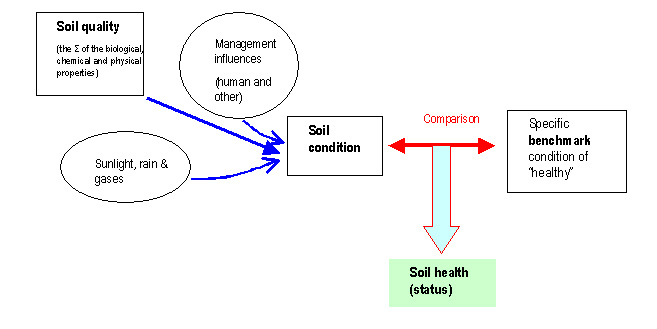
Soil health
Encyclopedia
Soil health is an assessment of ability of a soil to meet its range of ecosystem functions as appropriate to its environment.
The underlying principle in the use of the term “soil health” is that soil is not just a growing medium, rather it is a living, dynamic and ever-so-subtly changing environment.
We can use the human health analogy and categorise a healthy soil as one:

Soil health is the condition of the soil in a defined space and at a defined scale relative to a described benchmark.
The definition of soil health may vary between users of the term as alternative users may place differing priorities upon the multiple functions of a soil.
Therefore, the term soil health can only be understood within the context of the user of the term, and their aspirations of a soil, as well as by the boundary definition of the soil at issue.
The generic aspects defining a healthy soil can be considered as follows:
This translates to:
An unhealthy soil thus is the simple converse of the above.
Aspects of soil health
The term soil health is used to assess the ability of a soil to:- Sustain plant and animal productivity and diversity;
- Maintain or enhance water and air quality;
- Support human health and habitation
The underlying principle in the use of the term “soil health” is that soil is not just a growing medium, rather it is a living, dynamic and ever-so-subtly changing environment.
We can use the human health analogy and categorise a healthy soil as one:
- In a state of composite well-being in terms of biological, chemical and physical properties;
- Not diseased or infirmed (ie not degraded, nor degrading), nor causing negative off-site impacts;
- With each of its qualities cooperatively functioning such that the soil reaches its full potential and resists degradation;
- Providing a full range of functions (especially nutrient, carbon and water cycling) and in such a way that it maintains this capacity into the future.
Conceptualisation of soil health

Soil health is the condition of the soil in a defined space and at a defined scale relative to a described benchmark.
The definition of soil health may vary between users of the term as alternative users may place differing priorities upon the multiple functions of a soil.
Therefore, the term soil health can only be understood within the context of the user of the term, and their aspirations of a soil, as well as by the boundary definition of the soil at issue.
Interpretation of soil health
Different soils will have different benchmarks of health depending on the “inherited” qualities, and on the geographic circumstance of the soil.The generic aspects defining a healthy soil can be considered as follows:
- “Productive” options are broad;
- Life diversity is broad;
- Absorbency, storing, recycling and processing is high in relation to limits set by climate;
- Water runoff quality is of high standard;
- Low entropy; and,
- No damage to, or loss of the fundamental components.
This translates to:
- A comprehensive cover of vegetation;
- Carbon levels relatively close to the limits set by soil type and climate;
- Little leakage of nutrients from the ecosystem;
- Biological productivity relatively close to the limits set by the soil environment and climate;
- Only geological rates of erosion;
- No accumulation of contaminants; and,
- The ecosystem does not rely excessively on inputs of fossil energy
An unhealthy soil thus is the simple converse of the above.
The measurement of soil health
On the basis of the above, soil health will be measured in terms of individual ecosystem services provided relative to the benchmark. Specific benchmarks used to evaluate soil health include CO2 release, humus levels, microbial activity, and available calcium.http://www.highbrixgardens.com/restore/healthy_soil.htmlSee also
- Dryland salinityDryland salinityDryland salinity is salinity that occurs in a landscape that is not irrigated, as distinct from irrigation salinity and urban salinity.-Overview:...
- Soil biodiversitySoil biodiversityThis discussion looks at the relationship of the soil to biodiversity, at some aspects of the soil that can be managed in relation to biodiversity, and raises some catchment management considerations.-Soil and biodiversity:...
- Soil carbonSoil carbonSoil carbon is the generic name for carbon held within the soil, primarily in association with its organic content. Soil carbon is the largest terrestrial pool of carbon. Humans have, and will likely continue to have, significant impacts on the size of this pool...
- Soil policy (Victoria, Australia)Soil policy (Victoria, Australia)This outlines soil policy in the State of Victoria, Australia. A policy, for this purpose, is a principle or course of action adopted or proposed by a definable group of people.-Overview:...
- Soil qualitySoil qualityThe proposed a definition, stating that ' is an account of the soil’s ability to provide ecosystem and social services through its capacities to perform its functions under changing conditions...
- Soil resilienceSoil resilienceSoil resilience refers to the ability of a soil to resist or recover their healthy state in response to destabilising influences - this is a subset of a notion of environmental resilience...
- Soil structureSoil structureSoil structure is determined by how individual soil granules clump or bind together and aggregate, and therefore, the arrangement of soil pores between them...
- Soil water (retention)Soil water (retention)Soils can process and contain considerable amounts of water. They can take in water, and will keep doing so until they are full, or the rate at which they can transmit water into, and through, the pores is exceeded. Some of this water will steadily drain through the soil and end up in the...
- Living Soils

